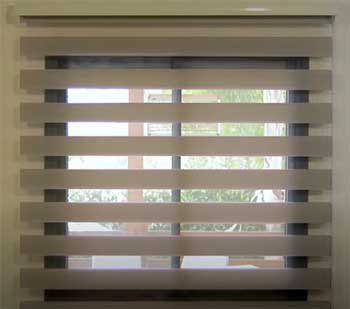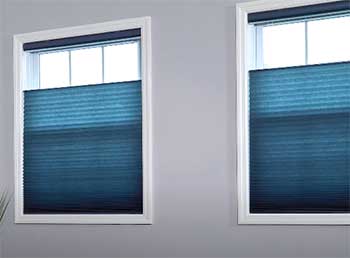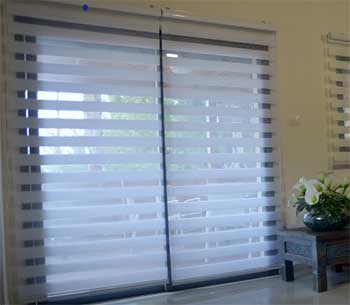If you’re in the market for new window treatments, you may be trying to decide between zebra blinds and cellular shades. Both offer unique aesthetic options for your home, but they differ in terms of functionality, cost, and installation.
This comprehensive guide will compare zebra blinds vs cellular shades so you can determine which is the better fit for your needs.
A Brief Comparison Table
| Feature | Zebra Blinds | Cellular Shades |
| Appearance | Bold striped pattern | Soft, layered fabric look |
| Materials | Vinyl, wood, aluminum slats | Woven fabrics like bamboo or linen |
| Privacy | Slats fully block light when lowered | Cells overlap when lowered for full privacy |
| Light Control | Slats adjust for stripes of light and privacy | Cells expand and contract to filter light |
| Insulation | Minimal | Excellent due to cellular air pockets |
| Exterior View | Stripes visible when blinds are down | Discreet appearance from outside |
| Safety | Cords can pose risk for kids/pets | Cordless operation safer |
| Durability | Durable with vinyl or aluminum slats | Lasting with quality woven materials |
| Cost | $20 – $100, more budget friendly | $100 – $300, higher end |
| Installation | Easy DIY install | Professional install recommended |
What Are Zebra Blinds?

Zebra blinds, also known as zebra shades or faux wood blinds, are a type of roller shade that consists of alternating strips of fabric in contrasting colors.
The most common color pattern is black and white, which creates a zebra-like striped appearance when the blind is fully raised.
However, zebra blinds can also come in other color combinations like gray and white or tan and dark brown.
The strips of fabric are usually made from materials like vinyl, polyester, acrylic, or even real wood veneers. The widths of the individual slats can range from 1 to 3 inches.
When raised, the slats stack neatly to allow maximum light into the room. And when lowered, the stripes provide both privacy and a unique decorative statement.
One of the biggest benefits of zebra blinds is the flexibility they provide for controlling light and privacy. You can easily adjust them to any position to allow just the right amount of incoming daylight. The slats are also effective at blocking outside views when fully lowered.
Other advantages of zebra blinds:
- Unique patterned look lends visual interest
- Slats made from vinyl or wood are low maintenance and easy to clean
- Allow more light through than solid fabric shades when partially open
- Offer full light blocking when closed
- Cordless operation is safe for homes with kids and pets
- Relatively affordable price point
What Are Cellular Shades?
Cellular shades, also called honeycomb shades, are made up of individual fabric cells or pockets that stack vertically. The cells are joined together in a honeycomb-like pattern, creating an insulating air pocket within each cell.
The cells can vary in size from 3/8 inch up to 2 inches wide.
Cellular shades are typically constructed from natural woven fabrics like bamboo, linen, or cotton. But some styles feature polyester or vinyl vanes instead. When raised, the individual cells contract and expand to allow optimal light control. Fully lowered, the cells expand and overlap to block outside light and views.
Compared to zebra blinds, cellular shades offer a few key differences:

- Cells create increased insulation to help reduce energy costs
- Fabric construction filters and softens incoming light
- Cells expand and contract vertically for flexible light control
- No visible cords increase safety
- Fabric provides a softer, more uniform look than slats
- Adds a casual, natural feel with woven materials
- Higher price point than zebra blinds
Now that you understand the basics of each blind style, let’s compare them across some key factors to help you decide which is best for your home.
Key Feature Comparison of Zebra Blinds And Cellular Shades
- Aesthetics
One of the biggest considerations when choosing window treatments is appearance. Here’s how zebra and cellular shades stack up aesthetically:
Zebra blinds make a bold visual statement with their distinctive striped pattern. The high-contrast colors and textures add an element of modern, funky style wherever they’re installed. Zebra blinds look especially eye-catching in contemporary homes, kids’ rooms, and stylish modern spaces.
Cellular shades have a much softer, more neutral appearance than zebra blinds. The layered fabric cells create subtle light filtering and shadow effects. The look is clean, uniform, and understated. Cellular shades suit traditional homes, master bedrooms, and offices nicely.
- Privacy
Both zebra blinds and cellular shades effectively block outside light and views when fully lowered. The side-by-side slats of zebra blinds offer full opacity. And the honeycomb structure of cellular shades prevents light leakage between cells.
When partially raised, zebra blinds give you stripes of openness between the slats which can reduce privacy somewhat. Cellular shades maintain better privacy when raised since the expanded cells still overlap each other to block views.
- Light Filtering
Here’s how zebra and cellular shades compare for controlling incoming daylight:
The stripes of alternating openness and opacity with zebra blinds let you regulate natural light effectively. Raising or lowering the blinds gives you wider or narrower stripes of light exposure.
Cellular shades put you in control of light by expanding and compressing the cells. Partially open cells soften and filter daylight beautifully by diffusing it through the layered fabric. Fully closed cells can black out a room completely.
- Insulation & Energy Efficiency
Cellular shades are the clear winner when it comes to insulation. The tiny air pockets within the closed cells create an effective thermal barrier that helps keep heat in during winter and block solar heat gain in summer. Zebra blinds provide minimal insulation value.
So if energy savings are a priority, cellular shades are the better choice for adding an extra layer of insulation to your windows.
- Appearance from Outside
For curb appeal, both zebra blinds and cellular shades allow you to control whether your windows appear open or closed from outside your home.
With zebra blinds, passersby can see the distinct striped pattern whether the blinds are up or down. So privacy is limited even when the blinds are fully closed.
The stacked, layered look of cellular shades provides a more discreet appearance from the exterior. When raised, the cells are compressed and hardly visible. And when lowered, they just look like neutral window coverings, not revealing any pattern or interior details.
- Child & Pet Safety
Cellular shades come out ahead for homes with kids and pets. Zebra blinds require pull cords to raise and lower the slats, posing possible risks of strangulation or entanglement.
Cellular shades are always cordless, containing no dangling pulls that could endanger children or animals. Without any cords to get tangled up in, they provide much safer operation.
- Durability
Zebra blinds and cellular shades both last a long time with proper care and cleaning.
Zebra blinds made with vinyl or aluminum slats are extremely durable while also being easy to wipe down. Their hard construction resists damage from moisture, sunlight, and daily wear and tear.
Woven wood or bamboo cellular shades are also built to last for many years. The natural fibers can lose their color over time when exposed to sunlight, but the woven material remains intact.
- Cost
Zebra blinds typically have a lower price point than cellular shades. The vinyl slat construction is affordable to produce. And you can cover a whole window with just one set of blinds.
With cellular shades, the woven fabric materials and honeycomb construction require more labor. Since each cell is individual, one shade covers just a portion of a window. So covering large windows involves a higher overall cost. But cellular shades offer added value through their superior insulation properties.
Here’s a quick price comparison:
- Zebra blinds – $20 – $100
- Cellular shades – $100 – $300
The specific cost depends on material, size, and brand. But zebra blinds generally fall on the lower end of the budget window treatment scale.
- Installation
Installing zebra blinds is a relatively straightforward process. The blinds come ready to mount inside or outside the window frame. You simply attach the brackets and click the blind into place similar to a standard roller shade.
Cellular shades require a bit more effort to install properly. Each individual cell needs to be level and evenly spaced within the mounting brackets. If DIY is not your thing, professional installation may be worth the additional cost.
Zebra Blinds Advantages
To summarize some of the key benefits of zebra blinds:

- Bold striped pattern provides distinctive style
- Durable vinyl and aluminum materials built to last
- Lower price point than cellular shades
- Easy installation as one complete unit
- Allows flexible light control through stripes
- Lends privacy when fully lowered
- Cordless or corded operation available
Cellular Shades Advantages
Here are some of the major advantages of cellular shades:
- Soft, neutral woven fabric appearance
- Excellent insulation and energy efficiency
- Material diffuses and softens incoming light
- Cells expand and contract for adjustable privacy
- Cordless design improves child safety
- Discreet exterior appearance
- Long-lasting natural woven materials
- Professional installation recommended
Now that we’ve spelled out how zebra blinds and cellular shades compare, it’s time to help you choose which is right for your home.
Should I Choose Zebra Blinds or Cellular Shades?
Zebra blinds and cellular shades each have their pros and cons. Keep these key factors in mind when deciding which option fits your needs best:
Zebra blinds are the way to go if you want:
- A bold, trendy striped pattern
- Vinyl or wood slats that are easy to clean
- To cover large windows affordably
- Flexible light control through adjustable slats
- Quick DIY installation
Cellular shades are preferable if you prefer:
- Softer, more subtle woven fabric look
- Natural materials like bamboo, linen or cotton
- Superior insulation and energy savings
- Diffused, filtered daylighting
- A discreet exterior appearance
- Cordless operation for safety
Take into account your priorities for style, functionality, and budget when deciding between these two window covering styles.
Zebra blinds fit best in contemporary spaces where you want to make a statement. Opt for cellular shades for their understated look, natural materials, and energy-efficient properties.
No matter which you choose, properly measuring your windows is an important first step. Having accurate window measurements ensures your new shades will fit perfectly. Installation is fairly straightforward for zebra blinds. Cellular shades usually benefit from professional help getting the honeycomb construction aligned and leveled.
With their respective advantages and disadvantages weighed, you can zero in on which option suits your home decor and functionality needs. The zebra stripes or cellular honeycomb pattern that fits your style and windows will help control light and transform the look of your interior space.
Frequently Asked Questions (FAQ)
Still have some questions about deciding between zebra blinds and cellular shades? These FAQs should help provide additional guidance:
Some potential downsides of zebra blinds include:
Don’t provide insulation like cellular shades
Pattern is visible from exterior even when lowered
Pull cords can pose safety hazard for kids and pets
Slats can bend or warp over time if made from lower quality materials
Pattern shows dust accumulation readily
Partial openings reduce privacy more than cellular shades
Zebra blinds are worth considering if you want an edgy striped look, durable vinyl construction, and a budget-friendly price. They make a strong style statement. Just keep in mind that cellular shades offer better insulation and more discreet privacy.
Advantages of zebra blinds include:
1. Trendy striped pattern options
2. Durable, easy-to-clean vinyl and aluminum slats
3. Cordless or corded operation
4. Adjustable stripes control privacy and light
5. Quick and easy installation
6. Cost effective price point
The main reasons people choose zebra blinds are:
1. Their unique striped appearance provides edgy style
2. The bold black and white or colored stripes make a decor statement
3. Adjustable slats allow customized light control
4. Durable vinyl maintains its look over time
5. More budget friendly price than many other blinds
6. Easy DIY installation even for large windows
The Takeaway
Zebra blinds and cellular shades provide two very distinct solutions for window treatments.
Zebra blinds offer adjustable striped slats that lend a bold, edgy look along with durable construction. They let you regulate light and privacy through the stripes for a fraction of the cost of other blinds.
Cellular shades take a more subtle approach with their honeycomb-like woven fabric cells diffusing light softly. Added insulation helps reduce energy costs. Cordless design improves safety. And the layered cellular construction allows for adjustable light filtering.
Now that you understand the pros and cons of each style, you can make an informed decision about which option best fits your home’s needs and aesthetic. Take stock of your priorities in terms of decor, features, budget, and ease of installation. Keep in mind these key comparisons:
- Zebra blinds for a bold striped pattern on a budget
- Cellular shades for a softer look and superior insulation
- Zebra blinds for large windows with easy DIY install
- Cellular shades for adjustable light filtering and safety
Whichever you choose, proper measurement and installation will ensure your new window treatments enhance your space beautifully and functionally. With this comprehensive guide’s insights, you can decide whether zebra blinds or cellular shades are the right fit for your home.
